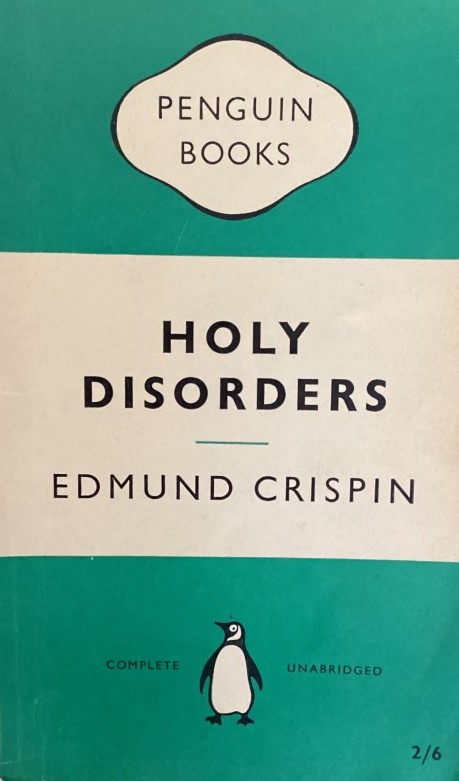Inspiring Older Readers
 posted on 18 May 2023
posted on 18 May 2023
Holy Disorders by Edmund Crispin
The detective fiction of Edmund Crispin (real name Bruce Montgomery) is one of my go-to reads when I feel the need to switch off a bit and relax with a writer who abides by a formula but doesn’t produce inane claptrap. You’ll find that I’ve already reviewed a couple of his other novels, The Moving Toyshop and Love Lies Bleeding, on the Letterpress Project site and this one pretty much follows the template I’ve described in those reviews.
Holy Disorders was published in 1945 and was Crispin’s second novel. Set at some point in the first two years of the war, this is a story that will include the evil machinations of German spies and a slightly odd diversion into the realms of rural witchcraft. Set in the fictional West Country cathedral town of Tolnbridge, the local church organist has been mysteriously attacked, hospitalised and subsequently murdered. Crispin’s eccentric, academic amateur sleuth, Gervese Fen, summons an old friend and early music specialist, Geoffrey Vintner to temporarily replace him. But before he even arrives in Tolnbridge, there are efforts being made on his life too.
Vintner’s eventful journey down to Tolnbridge occupies the first third of the novel and is actually a lengthy episode that illustrates superbly just how Crispin builds a story that is one part humour, one part mystery and suspense and a final part tongue-in-cheek academic references and puns. The result is one where the jeopardy is always there but carefully managed so that the reader remains a delighted observer rather than a participant being dragged into some surrogate peril.
As you might expect, as with Crispin’s other novels, there are plenty of twists and turns, red herrings and another murder before the meandering path leads to a solution we’re guided to by Fen. I’m determined not to uncover any more of the plot because it would be a terrible spoiler for anyone who wants to read this for the first time – these books are, after all, predicated on leading you down the garden path.
What I do want to focus on, however, is the character of Crispin’s central character, Gervese Fen. How much you like Crispin’s books will hinge to a great extent on how you take – or don’t take – to Fen. This being Crispin’s second novel, Fen is still, I think, in the process of being formed. Here his eccentricity (his new passion for the study of insects, for example, seems to occupy him almost as much as the murder) is perhaps more exaggerated than in some of the later outings and his willingness to put friends in peril, keep them in the dark and ignore their concerns is close to being damned annoying.
Crispin describes Fen as having "blue eyes and brown hair ineffectually plastered down with water ... There was something extraordinarily school-boyish about Gervase Fen. Cherubic. naive, volatile, and entirely delightful, he wandered the earth taking a genuine interest in things and people unfamiliar ... He was a man who lived almost entirely in the present"
He's an Oxford don, hugely self-opinionated and when he’s non-plussed he reaches for a phrase from Alice in Wonderland – ‘Oh my fur and whiskers’ – that helps cover his bewilderment.
He comes across as a force of nature – uncontrollable and unexpected. Murders and miscreants have no chance if they are unlucky enough to do their devilish deeds anywhere in Fen’s orbit.
As I have already said, how much you like Crispin will depend on how you take to Fen. When I was younger, I certainly fell under his spell and that enchantment has just never left me.
Paperback copies of Holy Orders can be found pretty cheaply on the second-hand market but the first edition hardbacks are expensive and difficult to find.
Terry Potter
May 2023